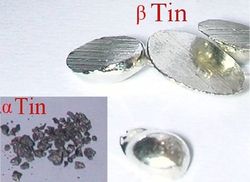Tin
|
|||||||||||||||||||||||||||||||||||||||||||||||||||||||||||||||||||||||||||||||||||||||||||||||||||||||||||||||||||||||||||||||||||||||||||||||||||||||||||||||||||||||||||||||||||||||||||
Tin is a chemical element with the symbol Sn (Latin: Stannum) and atomic number 50. It is a main group metal in group 14 of the periodic table. Tin shows chemical similarity to both neighboring group 14 elements, germanium and lead, like the two possible oxidation states +2 and +4. Tin is the 49th most abundant element and has, with 10 stable isotopes, the largest number of stable isotopes in the periodic table. Tin is obtained chiefly from the mineral cassiterite, where it occurs as tin dioxide, SnO2.
This silvery, malleable poor metal is not easily oxidized in air and is used to coat other metals to prevent corrosion. The first alloy used in large scale since 3000 BC was bronze, an alloy of tin and copper. After 600 BC pure metallic tin was produced. Pewter, which is an alloy of 85% to 90% tin with the remainder commonly consisting of copper, antimony and lead, was used for flatware from the Bronze Age until the 20th century. In modern times tin is used in many alloys, most notably tin/lead soft solders, typically containing 60% or more of tin. Another large application for tin is corrosion-resistant tin plating of steel. Because of its low toxicity, tin-plated metal is also used for food packaging, giving the name to tin cans, which are made mostly of steel.
Contents |
Characteristics
Physical and allotropes, and tin pest
Tin is a malleable, ductile, and highly crystalline silvery-white metal. When a bar of tin is bent, a crackling sound known as the tin cry can be heard due to the twinning of the crystals.[2]
β-tin(the metallic form), which exists at room temperature and hotter, is malleable; while the α-tin(nonmetallic form), formed when tin is cooled below 13.2 °C, is brittle. It has a diamond cubic crystal structure, similar to diamond, silicon or germanium. α-tin has no metallic properties at all. It is a dull-gray powdery material with no common uses, other than a few specialized semiconductor applications.[2] These two allotropes, α-tin and β-tin, are more commonly known as gray tin and white tin, respectively. Two more allotropes, γ and σ, exist at temperatures above 161 °C and pressures above several GPa.[3] Although the α-β transformation temperature is nominally 13.2 °C, impurities (e.g. Al, Zn, etc.) lower the transition temperature well below 0 °C, and upon addition of Sb or Bi the transformation may not occur at all, increasing the durability of the tin.[4]
This conversion is known as tin disease or tin pest. Tin pest was a particular problem in northern Europe in the 18th century as organ pipes made of tin alloy would sometimes be affected during long cold winters. Some sources also say that during Napoleon's Russian campaign of 1812, the temperatures became so cold that the tin buttons on the soldiers' uniforms disintegrated, contributing to the defeat of the Grande Armée. The veracity of this story is debatable, because the transformation to gray tin often takes a reasonably long time.[5]
Commercial grades of tin (99.8%) resist transformation because of the inhibiting effect of the small amounts of bismuth, antimony, lead, and silver present as impurities. Alloying elements such as copper, antimony, bismuth, cadmium, and silver increase its hardness. Tin tends rather easily to form hard, brittle intermetallic phases, which are often undesirable. It does not form wide solid solution ranges in other metals in general, and there are few elements that have appreciable solid solubility in tin. Simple eutectic systems, however, occur with bismuth, gallium, lead, thallium, and zinc.[4]
Chemical properties
See also Category: Tin compounds Tin resists corrosion from distilled, sea and soft tap water, but can be attacked by strong acids, alkalis, and acid salts. Tin can be highly polished and is used as a protective coat for other metals in order to prevent corrosion or other chemical action. Tin acts as a catalyst when oxygen is in solution and helps accelerate chemical attack.[2]
Isotopes
Tin is the element with the greatest number of stable isotopes, ten; these include all those with atomic masses between 112 and 124, with the exception of 113, 121 and 123. Of these, the most abundant ones are 120Sn (at almost a third of all tin), 118Sn, and 116Sn, while the least abundant one is 115Sn. The isotopes possessing even atomic numbers have no nuclear spin while the odd ones have a spin of +1/2. Tin, with its three common isotopes 115Sn, 117Sn and 119Sn, is among the easiest elements to detect and analyze by NMR spectroscopy, and its chemical shifts are referenced against SnMe4.[note 1][6]
This large number of stable isotopes is thought to be a direct result of tin possessing an atomic number of 50, which is a "magic number" in nuclear physics. There are 28 additional unstable isotopes that are known, encompassing all the remaining ones with atomic masses between 99 and 137. Aside from 126Sn, which has a half-life of 230,000 years, all the radioactive isotopes have a half-life of less than a year. The radioactive 100Sn is one of the few nuclides possessing a "doubly magic" nucleus and was discovered relatively recently, in 1994.[7] Another 30 metastable isomers have been characterized for isotopes between 111 and 131, the most stable of which being 121mSn, with a half-life of 43.9 years.
Etymology
The English word 'tin' is Germanic; related words are found in the other Germanic languages—German zinn, Swedish tenn, etc.—but not in other branches of Indo-European except by borrowing (e.g. Irish tinne). Its origin is unknown.[8]
The Latin name stannum originally meant an alloy of silver and lead, and came to mean 'tin' in the 4th century BCE[9]—the earlier Latin word for it was plumbum candidum 'white lead'. Stannum apparently came from an earlier stāgnum (meaning the same thing),[8] the origin of the Romance and Celtic terms for 'tin'.[8][10] The origin of stannum/stāgnum is unknown; it may be pre-Indo-European.[11] The Meyers Konversationslexikon speculates on the contrary that stannum is derived from Cornish stean, and is proof that Cornwall in the first centuries AD was the main source of tin.
Creation
Tin is created via the long S-process in low-medium mass stars (.6 -> 10 solar masses). This takes thousands of years to do. It requires an Indium atom to capture a neutron and then undergo Beta decay.
History
Antiquity
.jpg)
Tin extraction and use can be dated to the beginnings of the Bronze Age around 3000 BC, when it was observed that copper objects formed of polymetallic ores with different metal contents had different physical properties.[12] The earliest bronze objects had tin or arsenic content of less than 2% and are therefore believed to be the result of unintentional alloying due to trace metal content in the copper ore[13] It was soon discovered that the addition of tin or arsenic to copper increased its hardness and made casting much easier, which revolutionized metal working techniques and brought humanity from the Copper Age or Chalcolithic to the Bronze Age around 3000 BC.[13] Early tin exploitation appears to have been centered on placer deposits of cassiterite.[14]
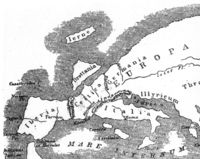
The first evidence of tin use for making bronze appears in the Near East and the Balkans around 3000 BC.[13] It is still unclear as to where the earliest tin was mined as tin deposits are very rare and evidence of early mining is scarce. Europe's earliest mining district appears to be located in Erzgebirge, on the border between Germany and Czech Republic and is dated to 2500 BC. From there tin was traded north to the Baltic Sea and south to the Mediterranean following the Amber Road trading route. Tin mining knowledge spread to other European tin mining districts from Erzgebirge and evidence of tin mining begins to appear in Brittany, Devon and Cornwall, and in the Iberian Peninsula around 2000 BC.[13] These deposits saw greater exploitation when they fell under Roman control between the third century BC and the first century AD.[15] Demand for tin created a large and thriving network amongst Mediterranean cultures of Classical times.[16][17] By the Medieval period, Iberia's and Germany's deposits lost importance and were largely forgotten while Devon and Cornwall began dominating the European tin market.[15]
In the Far East, the tin belt stretching from Yunnan province in China to the Malaysian Peninsula began being exploited sometime between the third and second milleniums BC. The deposits in Yunnan province were not mined until around 700 BC, but by the Han Dynasty had become the main source of tin in China according to historical texts of the Han, Jin, Tang, and Song dynasties.[18]
Other regions of the world developed tin mining industries at a much later date. In Africa, the Bantu culture extracted, smelted and exported tin between the 11th and 15th centuries AD,[13] in the Americas tin exploitation began around 1000 AD, and in Australia it began with the arrival of Europeans in the 17th century.
Modern times
During the Middle Ages, and again in the early 19th century, Cornwall was the major tin producer. This changed after large amounts of tin were found in the Bolivian tin belt and the east Asian tin belt, stretching from China through Thailand and Laos to Malaya and Indonesia. Tasmania also hosts deposits of historical importance, most notably Mount Bischoff and Renison Bell.
In 1931 the tin producers founded the International Tin Committee, followed in 1956 by the International Tin Council, an institution to control the tin market. After the collapse of the market in October 1985 the price for tin nearly halved.[19]
Today, the word "tin" is often improperly used as a generic term for any silvery metal that comes in sheets. Most everyday materials that are commonly called "tin", such as aluminium foil, beverage cans, corrugated building sheathing and tin cans, are actually made of steel or aluminium, although tin cans (tinned cans) do contain a thin coating of tin to inhibit rust. Likewise, so-called "tin toys" are usually made of steel, and may or may not have a coating of tin to inhibit rust. The original Ford Model T was known colloquially as the "Tin Lizzy".
Compounds and Chemistry
Tin forms the dioxide SnO2 (cassiterite) when it is heated in the presence of air. SnO2 is amphoteric and forms stannate (SnO32−) salts with bases and tin(IV) salts with acids. There are also stannates with the structure [Sn(OH)6]2−, like K2[Sn(OH)6], although the free stannic acid H2[Sn(OH)6] is unknown.
Tin combines directly with chlorine forming tin(IV) chloride, while reacting tin with hydrochloric acid in water gives tin(II) chloride and hydrogen gas. Several other compounds of tin exist in the +2 and +4 oxidation states, such as tin(II) sulfide and tin(IV) sulfide (Mosaic gold). There is only one hydride, however: stannane (SnH4), where tin is in the +4 oxidation state.[2]
The most important tin compound is tin(II) chloride (also known as stannous chloride), which has found use as a reducing agent and as a mordant in the calico printing process. Electrically conductive coatings are produced when tin compounds are sprayed onto glass. These coatings have been used in panel lighting and in the production of frost-free windshields.
Tin compounds such as tin(II) fluoride are added to some dental care products[20][21] as stannous fluoride (SnF2). Tin(II) fluoride can be mixed with calcium abrasives while the more common sodium fluoride gradually becomes biologically inactive combined with calcium compounds.[22] It has also been shown to be more effective than sodium fluoride in controlling gingivitis.[23]
Organotin compounds or stannanes are chemical compounds based on tin with hydrocarbon substituents.[24] Organotin compounds usually have high toxicity and have been used as biocides, but their use is slowly being phased out. The first organotin compound was diethyltin diiodide (Sn(C2H5)2I2), discovered by Edward Frankland in 1849. Organotin compounds differ from their lighter analogues of germanium and silicon in that there is a greater occurrence of the +2 oxidation state due to the "inert pair effect"; it also has a greater range of coordination numbers, and the common presence of halide bridges between polynuclear compounds. Most organotin compounds are colorless liquids or solids that are usually stable to air and water. The tetraalkyl stannates (R4Sn) always have a tetrahedral geometry at the tin atom. The halide derivatives R3SnX often form chained structures with Sn-X-Sn bridges. Alkyltin compounds are usually prepared via Grignard reagent reactions such as in:[25]
- SnCl4 + 4 RMgBr → R4Sn + 4 MgBrCl
Occurrence
See also Category: Tin minerals
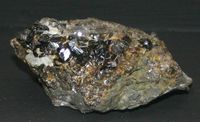
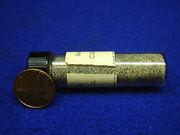
Tin is the 49th most abundant element in the Earth's crust, representing 2 ppm compared with 75 ppm for zinc, 50 ppm for copper, and 14 ppm for lead.[26]
Tin does not occur naturally by itself, and must be extracted from a base compound, usually cassiterite (SnO2). Cassiterite is the only commercially important source of tin, although small quantities of tin are recovered from complex sulfides such as stannite, cylindrite, franckeite, canfieldite, and teallite. Minerals with tin are almost always in association with granite rock, which, when they contain the mineral, have a 1% tin oxide content.[27]
Because of the higher specific gravity of tin dioxide, about 80% of mined tin is from secondary deposits found downstream from the primary lodes. Tin is often recovered from granules washed downstream in the past and deposited in valleys or under sea. The most economical ways of mining tin are through dredging, hydraulic methods or open cast mining. Most of the world's tin is produced from placer deposits, which may contain as little as 0.015% tin.
It was estimated in January 2008 that there were 6.1 million tons of economically recoverable primary reserves, from a known base reserve of 11 million tons. Below are the nations with the 10 largest known reserves.
Estimates of tin production have historically varied with the dynamics of economic feasibility and the development of mining technologies, but it is estimated that, at current consumption rates and technologies, the Earth will run out of tin that can be mined in 40 years.[28] However Lester Brown has suggested tin could run out within 20 years based on an extremely conservative extrapolation of 2% growth per year.[29]
Secondary, or scrap, tin is also an important source of the metal and the recovery of tin through secondary production, or recycling of scrap tin, is increasing rapidly. While the United States has neither mined since 1993 nor smelted tin since 1989, it was the largest secondary producer, recycling nearly 14,000 tons in 2006.[30]
New deposits are reported to be in southern Mongolia,[31]
| Country | Reserves | Reserve base |
|---|---|---|
| 1,700,000 | 3,500,000 | |
| 1,000,000 | 1,200,000 | |
| 710,000 | 1,000,000 | |
| 800,000 | 900,000 | |
| 540,000 | 2,500,000 | |
| 450,000 | 900,000 | |
| 300,000 | 350,000 | |
| 170,000 | 250,000 | |
| 150,000 | 300,000 | |
| Other | 180,000 | 200,000 |
| Estimated economically recoverable world tin reserves in million tons[27] |
|
|---|---|
| 1965 | 4,265 |
| 1970 | 3,930 |
| 1975 | 9,060 |
| 1980 | 9,100 |
| 1985 | 3,060 |
| 1990 | 7,100 |
| 2008 | 6,100[32] |
Production
Tin is produced by reducing the ore with coal in a reverberatory furnace.
Mining and smelting
In 2006, total worldwide tin mine production was 321,000 tons, and smelter production was 340,000 tons. From its production level of 186,300 tons in 1991, around where it had hovered for the previous decades, production of tin increased 89% to 351,800 tons in 2005. Most of the increase came from China and Indonesia, with the largest spike in 2004–2005, when it increased 23%. While in the 1970s Malaysia was the largest producer, with around a third of world production, it has steadily fallen, and now remains a major smelter and market center. In 2007, the People's Republic of China was the largest producer of tin, where the tin deposits are concentrated in the southeast Yunnan tin belt,[33] with 43% of the world's share, followed by Indonesia, with an almost equal share, and Peru at a distant third, reports the USGS.[32]
The table below shows the countries with the largest mine production and the largest smelter output.[note 2]
| Country | Mine production | Smelter production |
|---|---|---|
| China | 114,300 | 129,400 |
| Indonesia | 117,500 | 80,933 |
| Peru | 38,470 | 40,495 |
| Bolivia | 17,669 | 13,500 |
| Thailand | 225 | 27,540 |
| Malaysia | 2,398 | 23,000 |
| Belgium | 0 | 8,000 |
| Russia | 5,000 | 5,500 |
| Congo-Kinshasa ('08) | 15,000 | 0 |
After the discovery of tin in what is now Bisie, North Kivu in the Democratic Republic of Congo in 2002, illegal production has increased there to around 15,000 tons.[35] This is largely fueling the ongoing and recent conflicts there, as well as affecting international markets.
Industry
The ten largest companies produced most of world's tin in 2007. It is not clear which of these companies include tin smelted from the mine at Bisie, Congo-Kinshasa, which is controlled by a renegade militia and produces 15,000 tons. Most of the world's tin is traded on the London Metal Exchange (LME), from 8 countries, under 17 brands.[36]
| Company | Polity | 2006 | 2007 | %Change |
|---|---|---|---|---|
| Yunnan Tin | China | 52,339 | 61,129 | 16.7 |
| PT Timah | Indonesia | 44,689 | 58,325 | 30.5 |
| Minsur | Peru | 40,977 | 35,940 | −12.3 |
| Malay | China | 52,339 | 61,129 | 16.7 |
| Malaysia Smelting Corp | Malaysia | 22,850 | 25,471 | 11.5 |
| Thaisarco | Thailand | 27,828 | 19,826 | −28.8 |
| Yunnan Chengfeng | China | 21,765 | 18,000 | −17.8 |
| Liuzhou China Tin | China | 13,499 | 13,193 | −2.3 |
| EM Vinto | Bolivia | 11,804 | 9,448 | −20.0 |
| Gold Bell Group | China | 4,696 | 8,000 | 70.9 |
Prices of tin were at $11,900 per ton as of Nov 24, 2008. Prices reached an all-time high of nearly $25,000 per ton in May 2008, largely because of the effect of the decrease of tin production from Indonesia, and have been volatile because of reliance from mining in Congo-Kinshasa.
Applications
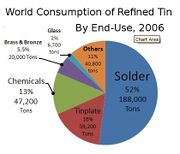
In 2006, about half of tin produced was used in solder. The rest was divided between tin plating, tin chemicals, brass and bronze, and other uses. See graph at right.[38]
Metal or alloy
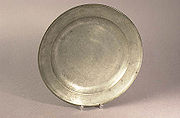
Tin is used by itself, or in combination with other elements for a wide variety of useful alloys. Tin is most commonly alloyed with copper. Pewter is 85–99% tin;[39] Babbitt metal has a high percentage of tin as well.[40][41] Bronze is mostly copper (12% tin), while addition of phosphorus gives phosphor bronze. Bell metal is also a copper-tin alloy, containing 22% tin.
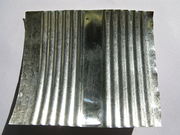
Tin bonds readily to iron, and is used for coating lead or zinc and steel to prevent corrosion. Tin-plated steel containers are widely used for food preservation, and this forms a large part of the market for metallic tin. A tinplate canister for preserving food was first manufactured in London in 1812. Speakers of British English call them "tins"; Americans call them "cans" or "tin cans". One thus-derived use of the slang term "tinnie" or "tinny" means "can of beer". The tin whistle is so called because it was first mass-produced in tin-plated steel.
Window glass is most often made via floating molten glass on top of molten tin (creating float glass) in order to make a flat surface (this is called the "Pilkington process").[42]
Most metal pipes in a pipe organ are made of varying amounts of a tin/lead alloy, with 50%/50% being the most common. The amount of tin in the pipe defines the pipe's tone, since tin is the most tonally resonant of all metals. When a tin/lead alloy cools, the lead cools slightly faster and makes a mottled or spotted effect. This metal alloy is referred to as spotted metal.[43][44]
Tin foil was once a common wrapping material for foods and drugs; replaced in the early 20th century by the use of aluminium foil, which is now commonly referred to as tin foil. Hence one use of the slang term "tinnie" or "tinny" for a small pipe for use of a drug such as cannabis or for a can of beer.
Tin becomes a superconductor below 3.72 K.[45] In fact, tin was one of the first superconductors to be studied; the Meissner effect, one of the characteristic features of superconductors, was first discovered in superconducting tin crystals.[46] The niobium-tin compound Nb3Sn is commercially used as wires for superconducting magnets, due to the material's high critical temperature (18 K) and critical magnetic field (25 T). A superconducting magnet weighing only a couple of kilograms is capable of producing magnetic fields comparable to a conventional electromagnet weighing tons.
Solder
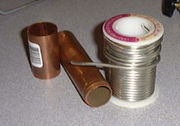
Tin has long been used as a solder in the form of an alloy with lead, tin comprising 5 to 70% w/w. Tin forms a eutectic mixture with lead containing 63% tin and 37% lead. Such solders are primarily used for solders for joining pipes or electric circuits. Since the European Union Waste Electrical and Electronic Equipment Directive (WEEED) and Restriction of Hazardous Substances Directive (RoHS) came into effect on 1 July 2006, the use of lead in such alloys has decreased. Replacing lead has many problems, including a higher melting point, and the formation of tin whiskers causing electrical problems. Replacement alloys are rapidly being found, however.[47]
Organotin compounds
Organotin compounds have the widest range of uses of all main-group organometallic compounds, with an annual worldwide industrial production of probably exceeding 50,000 tonnes. Their major application is in the stabilization of halogenated PVC plastics, which would otherwise rapidly degrade under heat, light, and atmospheric oxygen, to give discolored, brittle products. It is believed that the tin scavenges labile chlorine ions (Cl-), which would otherwise initiate loss of HCl from the plastic material.[25]
Organotin compounds have a relatively high toxicity, and for this they have been used for their biocidal effects in/as fungicides, pesticides, algacides, wood preservatives, and antifouling agents.[25] Tributyltin oxide is used as a wood preservative.[48]Tributyltin was used as additive for ship paint to prevent growth of marine organisms on ships. The use declined after organotin compounds were recognized as persistent organic pollutants with a extremely high toxicity for some marine organisms, for example the dog whelk.[49] The EU banned the use of organotin compounds in 2003.[50] Concerns over toxicity of these compounds to marine life and their effects over the reproduction and growth of some marine species,[25] (some reports describe biological effects to marine life at a concentration of 1 nanogram per liter) have led to a worldwide ban by the International Maritime Organization.[51] Many nations now restrict the use of organotin compounds to vessels over 25 meters long.[25]
The Stille reaction couples organotin compounds with organic halides or pseudohalides.[52]
Precautions
Tin plays no known natural biological role in humans, and possible health effects of tin are a subject of dispute. Tin itself is not toxic but most tin salts are.
See also
- Stannary
- Tinning
- Cassiterides (the mythical Tin Islands)
- Tin pest
- Whisker (metallurgy) (tin whiskers)
- Terne
- Tin mining in Britain
Notes
- ↑ Only H, F, P, Tl and Xe have a higher receptivity for NMR analysis for samples containing isotopes at their natural abundance.
- ↑ Estimates vary between USGS and The British Geological Survey. The latter was chosen because it indicates that the most recent statistics are not estimates, and estimates match more closely with other estimates found for Congo-Kinshasa.
References
- ↑ Magnetic susceptibility of the elements and inorganic compounds, in Handbook of Chemistry and Physics 81st edition, CRC press.
- ↑ 2.0 2.1 2.2 2.3 Holleman, Arnold F.; Wiberg, Egon; Wiberg, Nils; (1985). "Tin" (in German). Lehrbuch der Anorganischen Chemie (91–100 ed.). Walter de Gruyter. pp. 793–800. ISBN 3110075113.
- ↑ Molodets, A. M.; Nabatov, S. S. (2000). "Thermodynamic Potentials, Diagram of State, and Phase Transitions of Tin on Shock Compression". High Temperature 38 (5): 715–721. doi:10.1007/BF02755923.
- ↑ 4.0 4.1 Schwartz, Mel (2002). "Tin and Alloys, Properties". Encyclopedia of Materials, Parts and Finishes (2nd ed.). CRC Press. ISBN 1566766613.
- ↑ Le Coureur, Penny; Burreson, Jay (2004). Napoleon's Buttons: 17 Molecules that Changed History. New York: Penguin Group USA.
- ↑ "Interactive NMR Frequency Map". http://www.nyu.edu/cgi-bin/cgiwrap/aj39/NMRmap.cgi. Retrieved 2009-05-05.
- ↑ Walker, Phil (1994). "Doubly Magic Discovery of Tin-100". Physics World 7 (June). http://physicsworldarchive.iop.org/index.cfm?action=summary&doc=7%2F6%2Fphwv7i6a24%40pwa-xml&qt=.
- ↑ 8.0 8.1 8.2 Oxford English Dictionary, 2nd edition, 1989.
- ↑ Encyclopedia Britannica, 11th Edition, 1911, s.v. 'tin', citing H. Kopp
- ↑ "The Ancient Mining of Tin". http://www.oxleigh.freeserve.co.uk/pt77a.htm. Retrieved 2009-07-07.
- ↑ American Heritage Dictionary
- ↑ Cierny, J.; Weisgerber, G. (2003), "The "Bronze Age tin mines in Central Asia", in Giumlia-Mair, A.; Lo Schiavo, F., The Problem of Early Tin, Oxford: Archaeopress, pp. 23-31, ISBN 1841715646
- ↑ 13.0 13.1 13.2 13.3 13.4 Penhallurick, R.D. (1986), Tin in Antiquity: its Mining and Trade Throughout the Ancient World with Particular Reference to Cornwall, London: The Institute of Metals, ISBN 0904357813
- ↑ Charles, J.A. (1979), "The development of the usage of tin and tin-bronze: some problems", in Franklin, A.D.; Olin, J.S.; Wertime, T.A., The Search for Ancient Tin, Washington D.C.: A seminar organized by Theodore A. Wertime and held at the Smithsonian Institution and the National Bureau of Standards, Washington D.C. March 14–15, 1977, pp. 25-32
- ↑ 15.0 15.1 Gerrard, S. (2000), The Early British Tin Industry, Stroud: Tempus Publishing, ISBN 0752414526
- ↑ Lo Schiavo, F. (2003), "The problem of early tin from the point of view of Nuragic Sardinia", in Giumlia-Mair, A.; Lo Schiavo, F., The Problem of Early Tin, Oxford: Archaeopress, pp. 121-132, ISBN 1841715646
- ↑ Pulak, C. (2001), "The cargo of the Uluburun ship and evidence for trade with the Aegean and beyond", in Bonfante, L.; Karageogrhis, V., Italy and Cyprus in Antiquity: 1500-450 BC, Nicosia: The Costakis and Leto Severis Foundation, pp. 12-61, ISBN 9963810233
- ↑ Murowchick, R.E. (1991), The Ancient Bronze Metallurgy of Yunnan and its Environs: Development and Implications, Michigan: Ann Arbour
- ↑ Thoburn, John T. (1994). Tin in the World Economy. Edinburgh University Press. ISBN 0748605169.
- ↑ "Crest Pro Health". http://www.crest.com/prohealth/home.jsp. Retrieved 2009-05-05.
- ↑ "Colgate Gel-Kam". http://www.colgate.com/app/Colgate/US/OC/Products/FromTheDentist/GelKamStannousFluorideGel.cvsp. Retrieved 2009-05-05.
- ↑ Hattab, F. (April 1989). "The State of Fluorides in Toothpastes.". Journal of Dentistry 17 (2): 47–54. doi:10.1016/0300-5712(89)90129-2. PMID 2732364.
- ↑ Perlich, MA; Bacca, LA; Bollmer, BW; Lanzalaco, AC; McClanahan, SF; Sewak, LK; Beiswanger, BB; Eichold, WA et al. (1995). "The clinical effect of a stabilized stannous fluoride dentifrice on plaque formation, gingivitis and gingival bleeding: a six-month study.". The Journal of Clinical Dentistry 6 (Special Issue): 54–58. PMID 8593194.
- ↑ Sander H.L. Thoonen, Berth-Jan Deelman, Gerard van Koten (2004). "Synthetic aspects of tetraorganotins and organotin(IV) halides". Journal of Organometallic Chemistry (689): 2145–2157. http://igitur-archive.library.uu.nl/chem/2005-0622-182223/13093.pdf.
- ↑ 25.0 25.1 25.2 25.3 25.4 Atkins, Peter; Shriver, Duward F.; Overton, Tina and Rourke, Jonathan (2006). Inorganic chemistry (4 ed.). W.H. Freeman. pp. 343; 345. ISBN 0716748789.
- ↑ Emsley 2001, pp. 124, 231, 449 and 503
- ↑ 27.0 27.1 "Tin: From Ore to Ingot". International Tin Research Institute. 1991. http://www.itri.co.uk/pooled/articles/BF_TECHART/view.asp?Q=BF_TECHART_230527. Retrieved 2009-03-21.
- ↑ "How Long Will it Last?". New Scientist 194 (2605): 38–39. May 26, 2007. ISSN 4079 0262 4079.
- ↑ Brown, Lester (2006). Plan B 2.0. New York: W.W. Norton. pp. 109. ISBN 978-0393328318.
- ↑ 30.0 30.1 Carlin, Jr., James F.. "Minerals Yearbook 2006: Tin" (PDF). United States Geological Survey. http://minerals.usgs.gov/minerals/pubs/commodity/tin/myb1-2006-tin.pdf. Retrieved 2008-11-23.
- ↑ Kovalenko, V. I.; Yarmolyuk, V. V. (1995). "Endogenous rare metal ore formations and rare metal metallogeny of Mongolia". Economic Geology 90: 520. doi:10.2113/gsecongeo.90.3.520. http://econgeol.geoscienceworld.org/cgi/content/abstract/90/3/520.
- ↑ 32.0 32.1 Carlin, Jr., James F.. "Mineral Commodity Summary 2008: Tin" (PDF). United States Geological Survey. http://minerals.usgs.gov/minerals/pubs/commodity/tin/mcs-2008-tin.pdf.
- ↑ Shiyu, Yang (1991). "Classification and type association of tin deposits in Southeast Yunnan Tin Belt". Chinese Journal of Geochemistry 10 (1): 21–35. doi:10.1007/BF02843295.
- ↑ World Mineral Production 2002–06. British Geological Survey. p. 89. http://nora.nerc.ac.uk/3260/2/FINAL_WMP_2002_2006_COMPLETE_WEB.pdf. Retrieved 2009-07-07.
- ↑ Polgreen, Lydia (November 15, 2008). "The Spoils: Congo's Riches, Looted by Renegade Troops". New York Times. http://www.nytimes.com/2008/11/16/world/africa/16congo.html?ref=africa. Retrieved 2010-05-25.
- ↑ "International Tin Research Institute. LME Tin Brands". http://www.itri.co.uk/pooled/articles/BF_TECHART/view.asp?Q=BF_TECHART_303032. Retrieved 2009-05-05.
- ↑ "International Tin Research Institute. Top Ten Tin Producing Companies". http://www.itri.co.uk/pooled/articles/BF_TECHART/view.asp?Q=BF_TECHART_285697. Retrieved 2009-05-05.
- ↑ "ITRI. Tin Use Survey 2007". ITRI. http://www.itri.co.uk/pooled/articles/BF_TECHART/view.asp?Q=BF_TECHART_297350. Retrieved 2008-11-21.
- ↑ Hull, Charles (1992). Pewter. Osprey Publishing. pp. 1–5. ISBN 9780747801528. http://books.google.com/books?id=3_zyycVRw18C.
- ↑ Brakes, James (2009). "Introduction". Analysis of Babbit. BiblioBazaar, LLC. pp. 1–2. ISBN 9781110110926. http://books.google.com/books?id=hZ3zGS6by9UC&printsec=frontcover.
- ↑ Williams, Robert S. (2007). Principles of Metallography. Read books. pp. 46–47. ISBN 9781406746716. http://books.google.com/books?id=KR82QRlAgUwC&pg=PA46.
- ↑ Pilkington, L. A. B. (1969). "Review Lecture. The Float Glass Process". Proceedings of the Royal Society of London. Series A, Mathematical and Physical Sciences 314 (1516): 1–25. doi:10.1098/rspa.1969.0212. http://www.jstor.org/stable/2416528.
- ↑ Robert Palmieri, ed (2006). "Pipe Metal". Encyclopedia of keyboard instruments. New York: Garland. p. 411. ISBN 9780415941747. http://books.google.com/books?id=cgDJaeFFUPoC&pg=PT426.
- ↑ By George Ashdown Audsley (1988). "Metal Pipes: And the Materials used in their Construction". The Art of Organ Building Audsley, George Ashdown. Courier Dover Publications. p. 501. ISBN 9780486213156. http://books.google.com/books?id=I0h525OVoTgC&pg=PA501.
- ↑ Dehaas, W; Deboer, J; Vandenberg, G (1935). "The electrical resistance of cadmium, thallium and tin at low temperatures". Physica 2: 453. doi:10.1016/S0031-8914(35)90114-8.
- ↑ Meissner, W.; R. Ochsenfeld (1933). "Ein neuer effekt bei eintritt der supraleitfähigkeit". Naturwissenschaften 21 (44): 787–788. doi:10.1007/BF01504252.
- ↑ Black, Harvey. (2005). "Getting the Lead out of Electronics". Environmental Health Perspectives 113 (10): A682–5. PMID 16203230. PMC 1281311. http://www.pubmedcentral.nih.gov/articlerender.fcgi?artid=1281311.
- ↑ ed. by David N.-S. Hon; Nobuo Shiraishi. (2001). "Preservation of Wood". Wood and cellulosic chemistry. New York, NY: Dekker. p. 799. ISBN 9780824700249. http://books.google.de/books?id=pKiTzbEDy1QC&pg=PA799.
- ↑ Eisler, Ronald. "Tin Hazards To Fish, Wildlife, and Invertebrates: A Synoptic Review" (PDF). U.S. Fish and Wildlife Service Patuxent Wildlife Research Center. http://www.dtic.mil/cgi-bin/GetTRDoc?AD=ADA322822&Location=U2&doc=GetTRDoc.pdf.
- ↑ "Regulation (EC) No 782/2003 of the European Parlament and of the Council of 14 April 2003 on the prohibition of organotin compounds on ships". http://eur-lex.europa.eu/LexUriServ/LexUriServ.do?uri=OJ:L:2003:115:0001:0011:EN:PDF. Retrieved 2009-05-05.
- ↑ edited by Simone Dürr and Jeremy Thomason. (2008). "Fouling on Shipping". Biofouling. Oxford: Blackwell. p. 227. ISBN 9781405169264. http://books.google.de/books?id=pERX3gKmFy4C&pg=PT227.
- ↑ Farina, Vittorio; Krishnamurthy, Venkat; Scott, William J. (1997). "The Stille Reaction". Organic Reactions (New York: Wiley). doi:10.1002/0471264180.or050.01. ISBN 0471312738.
Bibliography
- CRC contributors (2006). David R. Lide (editor). ed. Handbook of Chemistry and Physics (87th ed.). Boca Raton, Florida: CRC Press, Taylor & Francis Group. ISBN 0-8493-0487-3.
- Emsley, John (2001). "Tin". Nature's Building Blocks: An A-Z Guide to the Elements. Oxford, England, UK: Oxford University Press. pp. 445–450. ISBN 0198503407. http://books.google.com/books?id=j-Xu07p3cKwC&printsec=frontcover.
- Stwertka, Albert (1998). "Tin". Guide to the Elements (Revised ed.). Oxford University Press. ISBN 0-19-508083-1.
- Greenwood, N. N.; Earnshaw, A. (1997). Chemistry of the Elements (2nd ed.). Oxford: Butterworth-Heinemann. ISBN 0-7506-3365-4.
- MacIntosh, Robert M. (1968). "Tin". In Clifford A. Hampel (editor). The Encyclopedia of the Chemical Elements. New York: Reinhold Book Corporation. pp. 722–732. LCCN 68-29938.
- Heiserman, David L. (1992). "Element 50: Tin". Exploring Chemical Elements and their Compounds. New York: TAB Books. ISBN 0-8306-3018-X.
External links
- WebElements.com – Tin
- Theodore Gray's Wooden Periodic Table Table: Tin samples and castings
- Base Metals: Tin
| H | He | ||||||||||||||||||||||||||||||||||||||||
| Li | Be | B | C | N | O | F | Ne | ||||||||||||||||||||||||||||||||||
| Na | Mg | Al | Si | P | S | Cl | Ar | ||||||||||||||||||||||||||||||||||
| K | Ca | Sc | Ti | V | Cr | Mn | Fe | Co | Ni | Cu | Zn | Ga | Ge | As | Se | Br | Kr | ||||||||||||||||||||||||
| Rb | Sr | Y | Zr | Nb | Mo | Tc | Ru | Rh | Pd | Ag | Cd | In | Sn | Sb | Te | I | Xe | ||||||||||||||||||||||||
| Cs | Ba | La | Ce | Pr | Nd | Pm | Sm | Eu | Gd | Tb | Dy | Ho | Er | Tm | Yb | Lu | Hf | Ta | W | Re | Os | Ir | Pt | Au | Hg | Tl | Pb | Bi | Po | At | Rn | ||||||||||
| Fr | Ra | Ac | Th | Pa | U | Np | Pu | Am | Cm | Bk | Cf | Es | Fm | Md | No | Lr | Rf | Db | Sg | Bh | Hs | Mt | Ds | Rg | Cn | Uut | Uuq | Uup | Uuh | Uus | Uuo | ||||||||||
|
|||||||||||||||||||||||||||||||||||||||||
|
|||||||||||||||||||||||||||||||||||||||||
|
|||||
